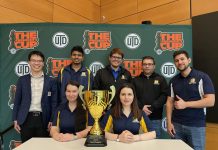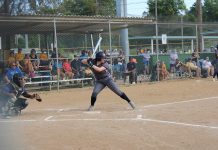An expression in business is that a person has to ‘spend money to make money.’ It is because of expenses that the Webster baseball team has actually improved according to team statistics.
Per the Department of Education’s Equity in Athletics Data Analysis database, from 2006-2016 Webster baseball’s operating expenses rose from just over $59,000 to over $185,000. Overall expenses went from just over $116,000 to more than $300,000.
These costs have produced a laundry list of achievements under head coach, six-time St. Louis Intercollegiate Athletic Conference (SLIAC) Coach of the Year Bill Kurich:
SLIAC regular season championships from 2006-2017, conference tournament championships from 2010-12, regional participation, a 2012 Central Regional title, a fifth place finish in the 2012 College World Series with three CWS appearances in the last six years.
In 2017, Kurich had an overall win-loss record of 358-146 and a conference win-loss record of 221-29, making him the winningest coach in team history.
While updated financial figures for 2017 to 2018 weren’t available, Webster University Director of Athletics Scott Kilgallon responded by saying one reason for this rise in costs is as simple as the uptick in the general cost of living.
Team growth is also important to factor in, which peaked under Kurich at 41 participants in 2014 and 37 as of Spring 2018. Webster baseball has also been the host of the NCAA Central Regional Championships for the last two years and will continue to do so. The NCAA reimburses the university for hosting the tournament, but the event also serves as another way to bring in potential new students as well.
However, the team must also pay for practice time as they do not have a facility of their own, but do have access to the professional venue of the Frontier League’s Gateway Grizzlies, GCS Credit Union Ballpark in nearby Sauget, Ill. An exact figure for the cost of practice was not disclosed.
The Gorloks also took a team-funded offseason trip to the Dominican Republic in 2016, which is allowed by the NCAA every three years. The trip spread the Webster name through play against local clubs (potentially bringing in new students) and furthered the team’s level of skill.
WU Athletics on YouTube: Webster Baseball journeys to Dominican Republic
“[A lot of those expenses] are ‘extras,’” Kilgallon said. “[That trip] is over $100,000. Not a penny of that is institutional money, but obviously, there’s a lot of aggressive fundraising for that. I think the university has done a good job of meeting the operational costs. The travel, the uniforms, feeding, overnights, is in line with what we do at other schools.”
Game day or operating expenses for all sports include, but are not limited to, cost of officials, the team’s bus contract, fuel and other costs already mentioned above, all of which fluctuate.
Webster baseball countered 2006-16 costs with a rise in revenue from a little less than $123,000 to more than $370,000 during the same time, but the battle between cost and revenue continues for all sports.
Including baseball, expenses for all men’s and women’s sports rose from about $938,000 in 2006 to more than $2.3 million in 2016. Despite this, revenue for all sports increased from just under $940,000 in 2006 to nearly $2.6 million in 2016 based on the same Equity in Athletics records.
“Since [Webster] is not-for-profit, you’re gaining that revenue through enrollment and retention,” Kilgallon said. “That’s where having a good athletics program helps the entire university because you’re attracting prospective students.”
While the university has attracted students, further advancement in both the classroom and on the field seems to indicate that expenses have paid off.
Back in June, Gorlok pitcher Josh Flemming, 21, had been drafted in the fifth round of the 2017 MLB Draft by the Tampa Bay Rays. DeVasto talked about the business manager, and his historic achievement.
“He was the first player on a SLIAC team to be drafted by the MLB in 19 years and only the second SLIAC baseball player to ever be drafted.“
A fellow computer science major Kyle Uhrich, 22, then signed with the Grizzlies shortly thereafter.
As far as academics, the team announced through a Facebook post on January 17, 2018, “Final grades are in from Fall Semester. Gorloks finished with a 3.26 team GPA. Highest team GPA since Coach Kurich took over the program.”



